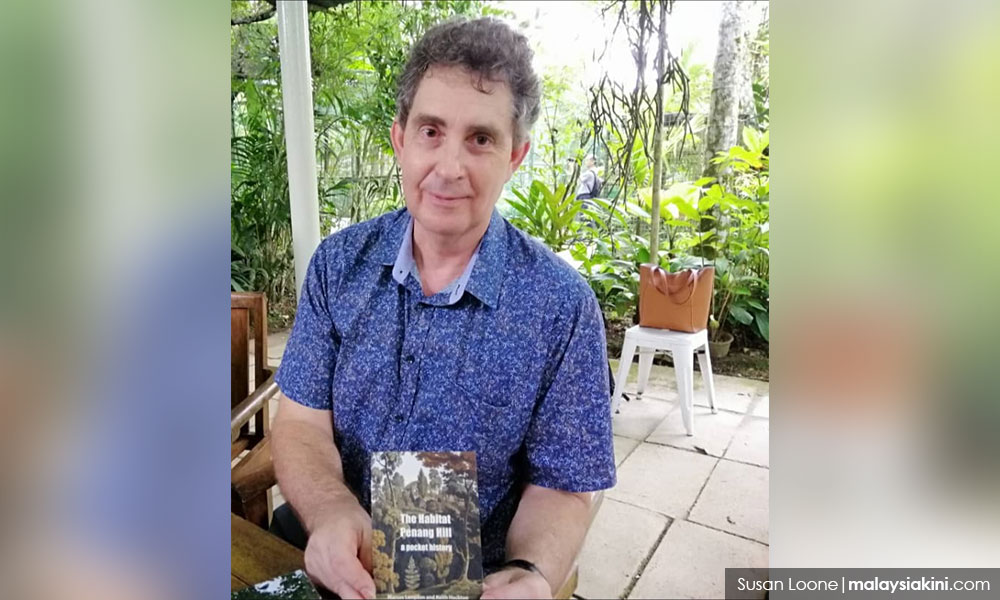
There is a signboard on top of the hill which reads, "You have not been to Penang until you visit Penang Hill".
While that may be true for some, Penang-based historian Marcus Langdon expressed concern about the future of the hill located within the Air Itam suburb, 9km west of George Town.
"There has to be more effort in understanding the history of the place," Langdon told Malaysiakini in an interview.
"Redevelopment is happening in various places in Penang involving the fort (Cornwallis) and the waterfront (Gurney Drive).
"If the heritage of these places is understood properly, then we can build on it, but first, we must understand," Langdon said.
"A detective of history" (as Langdon described himself) recalled that state government leaders, including former Penang chief minister Lim Guan Eng, had often remarked that one has to "understand the past to move forward to the future."
"This has to be practised. You have to really do it," said Langdon who is also director of his own publishing house, Entrepot Publishing, based at Kampung Malabar, George Town.
Langdon, who has focused his research on Penang for five years, is encouraged by a growing interest in the island's history.
"The appetite for understanding history is quite small, but I am encouraged by this talk on a Friday afternoon, which was able to attract some 55 to 60 participants although the weather was rather patchy," he noted.
The talk on the history of Penang Hill last Friday started off with Langdon saying that Penang Hill, the oldest hill station in this region, was established in 1793 by Captain Francis Light.
Light was the founder of the British colony of Penang and its capital city of George Town, although local folks claim their ancestors had made the island their home for decades before the captain arrived in 1786.

Light established a lookout on Flagstaff Hill (Penang Hill's colonial name) to warn Fort Cornwallis if there were any enemy ships approaching due to the war then between France and Britain.
At the same time, a little bungalow was built on the hill station for British East India Company officers and other Europeans to convalesce.
In the early years and until the last century, not many Europeans were allowed to stay or own property on the hill.
Later, however, many private individuals obtained grants to build properties, while a path leading up to the hill was also cleared for a funicular rail track to make the hill more accessible to all.
The rest, they say is history.
Langdon shared these nuggets of information at the Bellevue Hotel on the hill itself, an event held in conjunction with the Penang Hill Festival from July 18 to 21.
Published by his company, a book titled Penang Hill: A Journey through Time by author Mike Gibby, together with a booklet on the history of the hill's bungalows, were also launched at the event.
Langdon said there were many stories which could still be told about Penang Hill, which is host to some 1.5 million tourists yearly.
"There are various interesting places of which the history we are yet to explore, to get people to respect the heritage, like some of the bungalows, the old post office and the police station which was built in 1929," he said.
Asked if Penang Hill should curb the influx of tourists to protect it from human excesses, Langdon said, "there is no need to be restrictive, but there should be more control".
He was asked about the mushrooming of stalls on the hill as so-called tourist attractions, including gaudy-coloured photo booths, a tent for foot massages and a cafe with loud, blaring music.
He remarked that most of the stuff in souvenir shops were "Made in China" products and it would be better to give people a chance to buy locally-made items and to see and read material which was more related to the environment
Describing development on the hill as an "evolution", Langdon said the funicular railway, which has reduced travelling time to the hilltop to just eight minutes compared to 30 minutes in the past, had gained much popularity over the years.

"But it is going through a stage where discussions abound over having more galleries and respecting the hill's history instead of promoting commercial stuff.
"I think we'll get there," Langdon said, expressing concern over talks of a proposed cable car system, saying there would be many challenges and threats to the hills if it is implemented.
"We have to make sure it is sustainable and not overdo it," he noted.
He also agreed "in principle" with the hill's eco-tourism project dubbed "The Habitat", estimated to cost over RM3 million and developed by local engineering firm Creative Quest Sdn Bhd.
"It's a good way to promote the hill's botanic heritage, but a lot of money was spent on the project and cash has to keep rolling in to sustain the place," Langdon said.
Still, Langdon said he is amazed that there are many Penangites who are very protectiveof the hill.
"A clearing somewhere and people are up in arms over it. In any other place, there would already be many houses on the hills," he praised.
"In general, Penang protects its hills," he added, pointing out there are state laws prohibiting development above 76m from sea level.
"This is nice, such laws that protect the forests and catchment areas.
"Over the years, since the 1900s, Penang Hill has been cleared for one thing or another, but they have always been people who are agitating against such clearings or deforestation.
"People have always been concerned and quite a few papers have been written since the 1800s about deforestation on the hill and the damage, so people are aware of it, but the situation continues," said Langdon. - Mkini


No comments:
Post a Comment
Note: Only a member of this blog may post a comment.